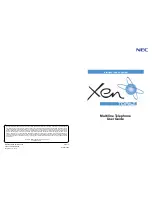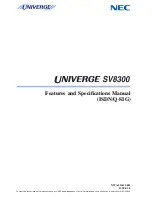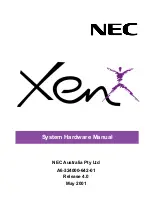
Tandem Ringing
Description
Tandem Ringing allows an extension user to have two telephones with one telephone number. For
example, extension 205 (the master telephone) sets Tandem Ringing with extension 206. When exten-
sion 205 receives an incoming call, both extensions 205 and 206 ring. Callers would dial the master
extension number (extension 205 in this example). When either the master telephone or slave tele-
phone is in use, the other telephone cannot be used for outgoing calls or incoming calls.
The multiline terminal must be paired with either a single line telephone or a Wireless DECT (SIP)
handset. It cannot be paired with another multiline terminal or a SIP terminal.
A single line telephone must be paired with another single line telephone or a Wireless DECT (SIP)
handset. It cannot be paired with a multiline telephone or a SIP terminal.
Conditions
•
The slave telephone cannot call the master telephone.
•
Extension numbers up to four digits can be registered on the Tandem Ringing key. Extension num-
bers over as well cannot be registered.
•
If Tandem Ringing is enabled, and one of the extensions is busy, no additional calls can be received
or placed from either telephone.
•
Tandem Ringing can support up to 128 pairs of Tandem Ringing extensions.
•
The extension user which enables Tandem Ringing is the master, while the slave telephone is the
extension entered by the user while setting up the feature.
•
A slave telephone ignores the settings for DND and follows the master telephone settings instead.
•
Voice Call is not supported on a multiline terminal with Tandem Ringing.
•
Calls placed on Hold while Tandem Ringing is active, immediately recall if the handset is placed On-
hook.
•
A slave telephone ignores the settings for Ring Groups and follows the master telephone settings
instead.
•
To transfer calls between the two Tandem Ringing stations, a System Park Orbit should be used.
•
A message waiting indication set for the master telephone only lights the message waiting LED on
the master telephone.
Default Settings
Disabled
System Availability
Terminals
Master Telephone:
TDM Multiline Terminals or Single Line telephones
Slave Telephone:
Single Line telephones or a Wireless DECT (SIP) handset.
Required Component(s)
ID using Wireless DECT (SIP) handsets (Refer to
Wireless DECT (SIP) on page 1-617
ISSUE 1.0
SL1000
T
Tandem Ringing
1-484
Summary of Contents for SL1000
Page 1: ...Features and Specifications Manual A50 031169 001 ISSUE 1 0 January 2011 ...
Page 41: ...Operation None ISSUE 1 0 SL1000 A Features and Specifications Manual 1 33 ...
Page 57: ...Operation None ISSUE 1 0 SL1000 B Features and Specifications Manual 1 49 ...
Page 95: ...Operation None ISSUE 1 0 SL1000 C Features and Specifications Manual 1 87 ...
Page 154: ...Operation None ISSUE 1 0 SL1000 D Data Line Security 1 146 ...
Page 324: ...Operation LCR Operation Flow Diagram ISSUE 1 0 SL1000 L LCR Least Cost Routing 1 316 ...
Page 325: ...LCR Dial LCR Dial Editing ISSUE 1 0 SL1000 L Features and Specifications Manual 1 317 ...
Page 326: ...LCR Cost Centre Code ISSUE 1 0 SL1000 L LCR Least Cost Routing 1 318 ...
Page 586: ...Memo ISSUE 1 0 SL1000 Features Availability by Software Revision 3 6 ...
Page 587: ...Memo ISSUE 1 0 SL1000 Features and Specifications Manual 3 7 ...
Page 588: ...Features and Specifications Manual NEC Corporation ISSUE 1 0 ...
















































